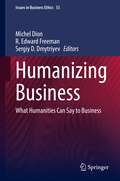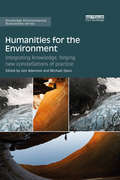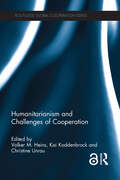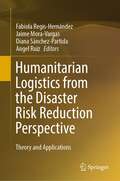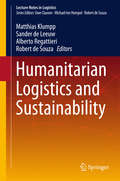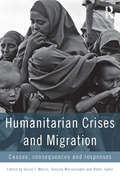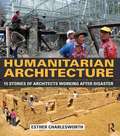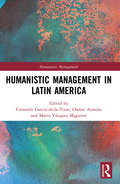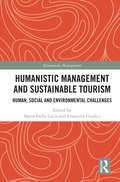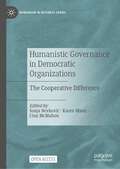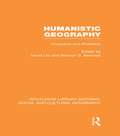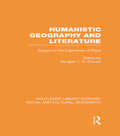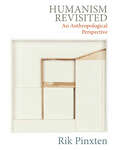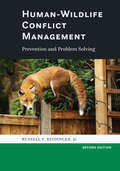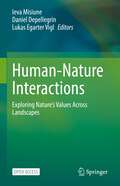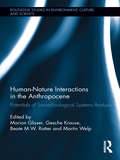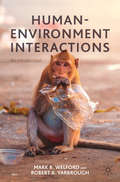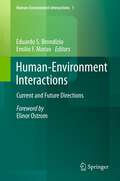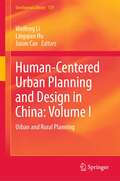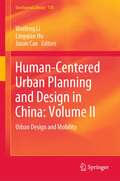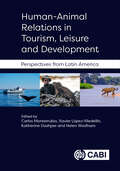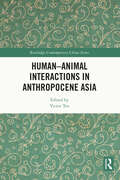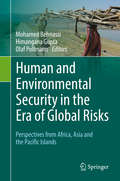- Table View
- List View
Humanizing Business: What Humanities Can Say to Business (Issues in Business Ethics #53)
by R. Edward Freeman Michel Dion Sergiy D. DmytriyevThis book is about humanizing business. In contrast to the mainstream modern management and leadership literature, this book provides distinctly humane perspectives on business. The volume travels outside the world of business to explore what Humanities – such as Philosophy, History, Literature, Creative Arts, and Cultural Studies – can offer to business. Renowned scholars from different Humanities disciplines, as well as management researchers exploring the heritage of Humanities, convey what it actually means to make business more humane. The book strives to humanize business. It aims to show that it is not people who have to suppress their human feelings, aspirations, and beliefs when they are at their workplaces, but it is business itself that needs to be redefined by the human norms of human beings. Companies should care about their employees and other stakeholders letting them be themselves, i.e. be human, at work and beyond. The book will be of interest to management scholars across various business disciplines. It can also be used as teaching material in the classroom with MBA students, especially in Business Ethics, Business and Society, Sustainability, Organizational Behavior, Human Resource Management and other management courses. The volume will also be of interest to scholars that work in different Humanities fields and whose interests span organizations, management, and business. Finally, many practitioners in the business world, especially those in managerial and leadership positions, will find the book both thought-provoking and useful for them as well.Chapter 37 is available open access under a Creative Commons Attribution 4.0 International License via link.springer.com.
Humanities for the Environment: Integrating knowledge, forging new constellations of practice (Routledge Environmental Humanities)
by Michael Davis Joni AdamsonHumanities for the Environment, or HfE, is an ambitious project that from 2013-2015 was funded by a generous grant from the Andrew W. Mellon Foundation. The project networked universities and researchers internationally through a system of 'observatories'. This book collects the work of contributors networked through the North American, Asia-Pacific, and Australia-Pacific observatories. Humanities for the Environment showcases how humanists are working to 'integrate knowledges' from diverse cultures and ontologies and pilot new 'constellations of practice' that are moving beyond traditional contemplative or reflective outcomes (the book, the essay) towards solutions to the greatest social and environmental challenges of our time. With the still controversial concept of the 'Anthropocene' as a starting point for a widening conversation, contributors range across geographies, ecosystems, climates and weather regimes; moving from icy, melting Arctic landscapes to the bleaching Australian Great Barrier Reef, and from an urban pedagogical 'laboratory' in Phoenix, Arizona to Vatican City in Rome. Chapters explore the ways in which humanists, in collaboration with communities and disciplines across academia, are responding to warming oceans, disappearing islands, collapsing fisheries, evaporating reservoirs of water, exploding bushfires, and spreading radioactive contamination. This interdisciplinary work will be of great interest to scholars in the humanities, social sciences, and sciences interested in interdisciplinary questions of environment and culture.
Humanitarianism and Challenges of Cooperation (Routledge Global Cooperation Series)
by Volker M. Heins Kai Koddenbrock Christine UnrauHumanitarianism as a moral concept and an organized practice has become a major factor in world society. It channels an enormous amount of resources and serves as an argument for different kinds of interference into the "internal affairs" of countries and regions. At the same time, and for these very reasons, it is an ideal testing ground for successful and unsuccessful cooperation across borders. Humanitarianism and the Challenges of Cooperation examines the multiple humanitarianisms of today as a testing ground for new ways of global cooperation. General trends in the contemporary transformation of humanitarianism are studied and individual cases of how humanitarian actors cooperate with others on the ground are investigated. This book offers a highly innovative, empirically informed account of global humanitarianism from the point of view of cooperation research in which internationally renowned contributors analyse broad trends and present case studies based on meticulous fieldwork. This book will be of great interest to students and researchers in the areas of political science, international relations and humanitarianism. It is also a valuable resource for humanitarian aid workers.
Humanitarianism and Challenges of Cooperation (Routledge Global Cooperation Series)
by Volker M. Heins Kai Koddenbrock Christine UnrauHumanitarianism as a moral concept and an organized practice has become a major factor in world society. It channels an enormous amount of resources and serves as an argument for different kinds of interference into the "internal affairs" of countries and regions. At the same time, and for these very reasons, it is an ideal testing ground for successful and unsuccessful cooperation across borders.Humanitarianism and the Challenges of Cooperation examines the multiple humanitarianisms of today as a testing ground for new ways of global cooperation. General trends in the contemporary transformation of humanitarianism are studied and individual cases of how humanitarian actors cooperate with others on the ground are investigated. This book offers a highly innovative, empirically informed account of global humanitarianism from the point of view of cooperation research in which internationally renowned contributors analyse broad trends and present case studies based on meticulous fieldwork. This book will be of great interest to students and researchers in the areas of political science, international relations and humanitarianism. It is also a valuable resource for humanitarian aid workers.
Humanitarian Logistics from the Disaster Risk Reduction Perspective: Theory and Applications
by Angel Ruiz Diana Sánchez-Partida Fabiola Regis-Hernández Jaime Mora-VargasThis book aims to clarify the priorities of the Sendai Framework for the DRR 2015 – 2030, through gathering recent contributions addressing the different ways researchers define, measure, reduce, and manage risk in the challenge of the DRR. Beyond a discussion of the different definitions of disaster risk; this book provides contributions focused on optimization approaches that support the decision-making process in the challenge of managing DRR problems considering emerging disaster risks in the medium and long term, as well as national and local applications. Some of the topics covered include network flow problems, stochastic optimization, discrete optimization, multi-objective programming, approximation techniques, and heuristic approaches.The target audience of the book includes professionals who work in Linear Programming, Logistics, Optimization (Mathematical, Robust, Stochastic), Management Science, Mathematical Programming, Networks, Scheduling, Simulation, Supply Chain Management, Sustainability, and similar areas. It can be useful for researchers, academics, graduate students, and anyone else doing research in the field
Humanitarian Logistics and Sustainability
by Matthias Klumpp Sander Leeuw Alberto Regattieri Robert SouzaThis contributed volume combines conceptual and strategic research articles dealing with the "why" and "to what end" of sustainable operations in humanitarian logistics, as well as operational research contributions regarding the "how" from the United Nations as well as from researchers and organizations from different countries (Germany, Australia, Singapore, Netherlands, Italy, Denmark, Jordan). The target audience primarily comprises research experts, decision makers and practitioners in the field, but the book may also be beneficial for graduate students.
Humanitarian Crises and Migration: Causes, Consequences and Responses
by Susan F. Martin, Sanjula Weerasinghe and Abbie TaylorWhether it is the stranding of tens of thousands of migrant workers at the Libyan–Tunisian border, or the large-scale displacement triggered by floods in Pakistan and Colombia, hardly a week goes by in which humanitarian crises have not precipitated human movement. While some people move internally, others internationally, some temporarily and others permanently, there are also those who become "trapped" in place, unable to move to greater safety. Responses to these "crisis migrations" are varied and inadequate. Only a fraction of "crisis migrants" are protected by existing international, regional or national law. Even where law exists, practice does not necessarily guarantee safety and security for those who are forced to move or remain trapped. Improvements are desperately needed to ensure more consistent and effective responses. This timely book brings together leading experts from multi-disciplinary backgrounds to reflect on diverse humanitarian crises and to shed light on a series of exploratory questions: In what ways do people move in the face of crisis situations? Why do some people move, while others do not? Where do people move? When do people move, and for how long? What are the challenges and opportunities in providing protection to crisis migrants? How might we formulate appropriate responses and sustainable solutions, and upon what factors should these depend? This volume is divided into four parts, with an introductory section outlining the parameters of "crisis migration," conceptualizing the term and evaluating its utility. This section also explores the legal, policy and institutional architecture upon which current responses are based. Part II presents a diverse set of case studies, from the earthquake in Haiti and the widespread violence in Mexico, to the ongoing exodus from Somalia, and environmental degradation in Alaska and the Carteret Islands, among others. Part III focuses on populations that may be at particular risk, including non-citizens, migrants at sea, those displaced to urban areas, and trapped populations. The concluding section maps the global governance of crisis migration and highlights gaps in current provisions for crisis-related movement across multiple levels. This valuable book brings together previously diffuse research and policy issues under the analytical umbrella of "crisis migration." It lays the foundations for assessing and addressing real challenges to the status quo, and will be of interest to scholars, policy makers, and practitioners committed to seeking out improved responses and ensuring the dignity and safety of millions who move in the context of humanitarian crises.
Humanitarian Architecture: 15 stories of architects working after disaster
by Esther CharlesworthNever has the demand been so urgent for architects to respond to the design and planning challenges of rebuilding post-disaster sites and cities. In 2011, more people were displaced by natural disasters (42 million) than by wars and armed conflicts. And yet the number of architects equipped to deal with rebuilding the aftermath of these floods, fires, earthquake, typhoons and tsunamis is chronically short. This book documents and analyses the expanding role for architects in designing projects for communities after the event of a natural disaster. The fifteen case studies featured in the body of the book illustrate how architects can use spatial sensibility and integrated problem-solving skills to help alleviate both human and natural disasters. The cases include: Lizzie Babister - Department of International Development, UK. Shigeru Ban - Winner of The Pritzker Architecture Prize 2014, Shigeru Ban Architects and Voluntary Architects’ Network, Japan. Eric Cesal – Disaster Reconstruction and Resiliency Studio and Architecture for Humanity, Japan. Hsieh Ying Chun – Atelier 3, Taiwan. Nathaniel Corum - Education Outreach and Architecture for Humanity, USA. Sandra D’Urzo - Shelter and Settlements and International Federation of the Red Cross and Red Crescent Societies, Switzerland. Brett Moore - World Vision International, Australia. Michael Murphy - MASS Design Group, USA. David Perkes - Gulf Coast Community Design Studio, USA. Paul Pholeros - Healthabitat, Australia. Patama Roonrakwit - Community Architects for Shelter and Environment, Thailand. Graham Saunders - International Federation of Red Cross and Red Crescent Societies, Switzerland. Kirtee Shah - Ahmedabad Study Action Group, India. Maggie Stephenson - UN-HABITAT, Haiti. Anna Wachtmeister - Catholic Organisation for Relief and Redevelopment Aid, the Netherlands. The interviews and supporting essays show built environment professionals collaborating with post-disaster communities as facilitators, collaborators and negotiators of land, space and shelter, rather than as ‘save the world’ modernists, as often portrayed in the design media. The goal is social and physical reconstruction, as a collaborative process involving a damaged community and its local culture, environment and economy; not just shelter ‘projects’ that ‘build’ houses but leave no economic footprint or longer-term community infrastructure. What defines and unites the architects interviewed for Humanitarian Architecture is their collective belief that through a consultative process of spatial problem solving, the design profession can contribute in a significant way to the complex post-disaster challenge of rebuilding a city and its community.
Humanistic Management in Latin America (Humanistic Management)
by Consuelo A. García-de-la-Torre; Osmar Arandia; Mario Vázquez-MaguirreHumanistic management has been part of a growing conversation about a different approach to management that contributes to dignity in the workplace and better organisations overall. The theoretical concepts have mostly derived from developed countries. This book seeks to redress the balance and looks at the development and application of the concepts, approaches and models of inequality, corruption, poverty, and uncertainty in the context of Latin America. The book provides a comprehensive overview of what is happening in Latin America in terms of Humanistic Management and the promotion of the Sustainable Development Goals. The first section describes the development of Humanistic Management by reviewing two different schools that have strongly influenced the discipline: the Montreal School and the Saint Gallen School. Humanistic Management is then presented as a model that can be used by scholars and practitioners in Latin America. The third part aims to explore how Humanistic Management has been, and could be, implemented across different organizations and business sectors in Latin America. Part four examines the implications of Humanistic Management for external stakeholders such as customers and consumers, suppliers, community, government, and universities. Finally, the conclusion provides new approaches to Humanistic Management for Latin America. Humanistic Management in Latin America will serve as a key reference and resource for teachers, researchers, students, experts and policy makers, who want to acquire a broad understanding of social responsibility and business across the world.
Humanistic Management and Sustainable Tourism: Human, Social and Environmental Challenges (Humanistic Management)
by Maria Della Lucia Ernestina GiudiciTourism is a fast-growing and changing industry, which has become a driver of economic development in both developed and underdeveloped countries. While the tourism industry’s potential for shared value creation and sustainable development is acknowledged, the concerns around the environmental and social pressures remain a challenge for businesses, organizations, and destinations. This is because sustainable tourism arguably conflicts with the predominant neoliberal structure of the economy and with the hierarchical, profit- and consumption-driven societies. The emphasis on competition, growth, and profitability may undermine economic viability itself by consuming unreproducible resources and by undermining the six essential elements—dignity, people, prosperity, social justice, planet, and partnership—that are conceptually linked to sustainable development. The crises recurrently challenging the global travel and tourism environment, including climate change, bushfires, extreme weather disasters, pandemics, and the financial crisis, show the weaknesses of neoliberal approaches and the collective economic dependency of countries on tourism that is vulnerable, if not completely unsustainable. This vulnerability asks for understanding that the collective future depends on developing entirely new approaches and interpretation of tourism to effectively respond to the human, societal, social, and climate challenges. This book offers a novel and original perspective entailing the application of a humanistic management approach to sustainable tourism, which is centered on the value of human life, the protection of human dignity and the promotion of well-being. Multiple theoretical approaches, methods, and practical cases, on an international scale, shed light on shared value creation and human dignity as a necessary condition for its achievement in different contexts. Implicitly and explicitly, they respond to the current urgency to implement strategies to recover from the worldwide impact of the pandemic crisis and to provide a vision of what tourism could and should be when it recovers. It will be of interest to researchers, academics, professionals, and postgraduates in the fields of management, sustainability, and tourism development.
Humanistic Governance in Democratic Organizations: The Cooperative Difference (Humanism in Business Series)
by Cian McMahon Sonja Novković Karen MinerThis open access edited book brings together a number of theories under the umbrella of humanistic governance to develop a persuasive alternative perspective on governance, particularly for democratic organisations such as co-operatives. It examines how we can move beyond a profit-first approach to governance, into a framework that prioritises human dignity in all aspects of an operation. This book also discusses key issues for different types of cooperatives and how these might be addressed. And, finally, it addresses how cooperatives can better cope with dynamic change processes. This book will be of interest for academics working in the areas of stakeholder governance, social solidarity economy, ethical management and co-operatives.
Humanistic Geography: Problems and Prospects (Routledge Library Editions: Social and Cultural Geography)
by David Ley Marwyn S. SamuelsHumanistic geography now has an established position in the intellectual development of contemporary geography. However there has so far been little attempt to draw together the humanistic approach in one broad statement. This book by the leading figures in the field provides a platform for the exposition of humanistic geography in all its aspects.
Humanistic Geography and Literature: Essays on the Experience of Place (Routledge Library Editions: Social and Cultural Geography)
by Douglas C. D. PocockThis book introduces the beginning student to the major concepts, materials and tools of the discipline of geography. While it presents geographic theory, as whole and for each of its parts, the chief emphasis is on concrete analysis and example rather than on abstraction, an approach which has proven more successful for undergraduate courses than those with a more heavily theoretical bias. The text was extensively re-written for the third edition, which enhanced its clarity and effectiveness, with expanded cartographic coverage.
Humanism Revisited: An Anthropological Perspective
by Rik PinxtenThe West emancipated itself from the old humanism long ago and in doing so distanced itself from ‘heteronomy’: it declared that man, and not a non-human power, should be the first reference to approach people and nature. Today, as heirs of this tradition, we are still stuck in Eurocentrism (and often racism), and now even threaten to ruin nature by destroying biodiversity and causing the climate to warm up dangerously. Applied through an anthropological perspective, this book calls for a NEED-humanism: Not-Eurocentric, Ecological and (economically) Durable approach that can help promote inclusion and pluralism.
Human-Wildlife Conflict Management: Prevention and Problem Solving
by Russell F. Reidinger Jr.The latest edition of this classic guide details how to understand and resolve a broad array of human-wildlife conflicts.This new edition of Human-Wildlife Conflict Management updates our understanding of the human dimensions, as well as biological and ecological concepts, underlying human-wildlife conflicts. While it provides wildlife professionals and students with the knowledge and adaptive management strategies to resolve such conflicts, it uniquely explores negative interactions with a wide range of wildlife taxa beyond those typically covered in traditional wildlife damage management, including invasive plants, invertebrates, and fish.Designed to help students and natural resource practitioners gain a deeper understanding of how to successfully avoid and resolve conflict between humans and wildlife, it is informed by author Russell F. Reidinger's decades of teaching students and professionals how to anticipate and manage human-wildlife conflicts, as well as his experience leading a national research program devoted to this work.The book covers important human-wildlife topics such as:• individual-, population-, and ecosystem-level effects• survey techniques• management methods• human dimensions• economic issues• legal and political aspects• damage management strategiesFeaturing explanations of important terminology and pertinent biological and ecological concepts, Reidinger also shares the latest research, provides a plethora of real-world examples, and includes suggestions for additional resources.
Human-Nature Interactions: Exploring Nature’s Values Across Landscapes
by Ieva Misiune Daniel Depellegrin Lukas Egarter ViglThis edited volume aims to widen the discussion about the diversity of human-nature relationships and valuation methods and to stimulate new perspective that are needed to build a more sustainable future, especially in face of ongoing socio-environmental changes. Conceptual and empirical approaches, including qualitative, quantitative, and mixed methodologies have been used to highlight the importance of an integrative understanding of socio-ecological systems, where healthy ecosystems underpin the quality of life and societal activities largely drive environmental changes. Readers will obtain a comprehensive overview of the many and diverse ways the relationships between people and nature can be characterized. This includes understanding how people assign values to nature, discuss how human-nature interactions are shaped and provide examples of how these values and interactions can be systematically assessed across different land systems in Europe and beyond. This open access book is produced by internationally recognized scientists in the field but written in an accessible format to be of interest to a large audience, including prospective students, lecturers, young professionals and scientists embarking to the interdisciplinary field of socio-ecological research and environmental valuation.
Human-Nature Interactions in the Anthropocene: Potentials of Social-Ecological Systems Analysis (Routledge Studies in Environment, Culture, and Society)
by Gesche Krause Beate M.W. Ratter Marion Glaser Martin Welp Andrew HallidayThis book deals with the potentials of social-ecological systems analysis for resolving sustainability problems. Contributors relate inter- and transdisciplinary perspectives to systemic dynamics, human behavior and the different dimensions and scales. With a problem-focused, sustainability-oriented approach to the analysis of human-nature relations, this text will be a useful resource for scholars of human and social ecology, geography, sociology, development studies, social anthropology and natural resources management.
Human-Environment Interactions: An Introduction
by Mark R. Welford Robert A. YarbroughThis textbook explores the growing area of human-environment interaction. We live in the Anthropocene, an era dominated by humans, but also by the positive yet destructive environmental feedbacks that are poised to completely reset the relationships between nature and society. Modern and historic political, social, and cultural processes and physical landscape responses determine the intensity of these impacts. Yet different cultural groups, political and economic entities view, react to, and impact these human-environmental processes in spatially distinct and divergent ways. Providing an accessible, up-to-date, approach to human-environment interactions with balanced coverage of both social and natural science approaches to core environmental issues, this textbook is an integrative, multi-disciplinary offering that discusses environmental issues and processes within the context of human societies. The book begins by addressing the three most pressing issues of our time: climate change, threshold exceedance, and the 6th mass extinction. From there the authors identify within chapters on resources, population, agriculture and urbanization what precipitated and continues to sustain these three issues. They end with a chapter outlining some practical solutions to our human-environment crises.The book will be a valuable resource for interdisciplinary environment related courses bridging the gap between the social and natural sciences, human geographies and physical geographies.
Human-Environment Interactions
by Emilio F. Moran Eduardo S. BrondízioDrawing on research from eleven countries across four continents, the 16 chapters in the volume bring perspectives from various specialties in anthropology and human ecology, institutional analysis, historical and political ecology, geography, archaeology, and land change sciences. The four sections of the volume reflect complementary approaches to HEI: health and adaptation approaches, land change and landscape management approaches, institutional and political-ecology approaches, and historical and archaeological approaches.
Human-Centered Urban Planning and Design in China: Urban and Rural Planning (GeoJournal Library #129)
by Jason Cao Weifeng Li Lingqian HuThis book explores a more human-centered development pathway associated with the ideological shift from "quantity" to "quality" growth in the new era of Chinese urbanization. Sustainable urban and rural planning should be “people-centered” and concerned about urban-rural coordination. The authors argue that successful urban and rural development in China should promote social equity, culture diversity, economic prosperity and sustainable built form. This book prompts Chinese urbanists to reconsider and explore a sustainable and people-first planning approach with Chinese characteristics. The breadth and depth of this book is of particular interest to the faculty members, students, practitioners and the general public who are interested in subjects like urban and regional planning, rural planning, housing and community development, infrastructure planning, climate change and ecological planning, environmental planning, social equity and beyond. This book dealing with human-centered urban planning and development, rural planning and urban-rural coordination in China is part of a 2 volume set. Volume II discusses human-centered urban design and placemaking, human activities and urban mobility.
Human-Centered Urban Planning and Design in China: Urban Design and Mobility (GeoJournal Library #130)
by Jason Cao Weifeng Li Lingqian HuThis book provides insights and discusses human-centered urban design and placemaking, human activities and urban mobility in China. It argues that sustainable urban design and mobility should be “people-centered” and concerned about “place-making” in the new era of Chinese urbanization. Successful urban design and placemaking should adopt interdisciplinary approaches to planning and designing “space” and “place”. A core vision is the delivery of urban spaces that can cater to the needs of an increasingly diverse crowd of urban dwellers calling cities home. The book prompts Chinese urbanists to reconsider and explore a sustainable and people-first planning and design approach with Chinese characteristics. The breadth and depth of this book is of particular interest to those faculty members, students, practitioners and the general public who are interested in subjects like urban design, transport planning, mobility analysis and planning, housing and community development, infrastructure planning, environmental planning, social equity and beyond. This book discussing human-centered urban design and placemaking, human activities and urban mobility is part of a 2 volume set. Volume I deals with human-centered urban planning and development, rural planning and urban-rural coordination in China.
Human-Animal Relations in Tourism, Leisure and Development: Perspectives from Latin America
by Katherine Dashper Carlos Monterrubio Xavier López-Medellín Helen WadhamHumans and animals have developed multiple and complex interactions in the fields of tourism, leisure, and development. However, much of the existing research on how humans and animals interact in these fields has emerged from within the context of developed countries. As a result, little has been documented about human-animal interactions in the socioeconomic, cultural, and environmental contexts of countries in the Global South. Specifically, the diversity and complexity of interspecies relationships in tourism, leisure, and local development in Latin America have been largely ignored in Anglo-Saxon literature. This has resulted in a limited, partial, and hegemonic understanding and debate about human-animal relationships globally, dominated by certain regions of the world. This book addresses this gap by documenting multiple and complex relationships between humans and animals in the fields of tourism, leisure, and local development in countries in Latin America. The book: Brings together empirical and conceptual works that reveal different disciplinary, theoretical, ethical, methodological, and practical perspectives. Reveals how human-animal relationships - both domestic and wild - can result in co-created interspecies experiences, conflicts, conservation efforts, welfare, and local development of human societies in the region. Equips stakeholders with conceptual frameworks and actionable tools to formulate policies that blend animal welfare and sustainability in Latin American tourism and recreation strategies. Challenges dominant narratives from the Global North regarding tourism and conservation, promoting a more inclusive and nuanced approach. This book will be of interest to researchers, professionals and policymakers within tourism, leisure, animal welfare, conservation and destination development.
Human-Animal Interactions in Anthropocene Asia (Routledge Contemporary China Series)
by Victor TeoThis book examines the theme of human-animal interactions contextualized against the idea of the Anthropocene. Focused on China and its immediate Asian borderlands, this interdisciplinary collection provides a powerful and insightful analysis of the ecological challenges that mankind’s traditional activities have created. Through in-depth case studies, each focusing on a particular human-animal dynamic, the book contextualises and advances the understanding of existing environmental and ecological problems faced by local communities in Asia. In particular, the book hopes to transcend the duality of the nature versus culture debate by locating animal-ecological problems in the behavior of human institutions, beliefs and practices, which are often affected by prevailing cultural proclivities, political ideologies, economic interests and scientific agendas. Through interrogation of theoretical concepts of Anthropocene and human-animal binary, the volume highlights the controversial debates that follows their usage as well as their empirical utility understanding human-animal interactions historically, thereby engaging a broader interdisciplinary conversation is increasingly links these two fields together. Providing a platform for discussion and dialogue for a wide audience, this book will appeal to students and scholars of environmental history and politics, anthropology, political science and policy studies, China studies and Asian studies more generally.
Human and Environmental Security in the Era of Global Risks: Perspectives from Africa, Asia and the Pacific Islands
by Mohamed Behnassi Olaf Pollmann Himangana GuptaThis book discusses ways to deepen the debate on the linkages between global risks and human and environmental security. The approach put forward in this book is one of questioning the ability of existing concepts, regulatory frameworks, technologies and decision-making mechanisms to accurately deal with emerging risks to human and environmental security, and to act in the direction of effectively managing their impacts and fostering the resilience of concerned systems and resources. Empirical research findings from Africa, Asia and the Pacific Islands are provided.During the last decades the links between emerging risks and the security of humans and nature have been the object of considerable research and deliberations. However, it is only recently becoming an important focus of policy making and advocacy. In this contributed volume, it is presumed that the ability – or lack thereof – to make innovative conceptual frameworks, institutional and policy arrangements, and technological advances for managing the current emerging risks, will foster or undermine the environmental security, and consequently determine the future human security. Moreover, taking into account the links between environmental/climate security, human security and sustainability will help frame a new research agenda and potentially develop a broad range of responses to many delicate questions.
Human and Environmental Justice in Guatemala
by Stephen Henighan Candace JohnsonIn 1996, the Guatemalan civil war ended with the signing of the Peace Accords, facilitated by the United Nations and promoted as a beacon of hope for a country with a history of conflict. Twenty years later, the new era of political protest in Guatemala is highly complex and contradictory: the persistence of colonialism, fraught indigenous-settler relations, political exclusion, corruption, criminal impunity, gendered violence, judicial procedures conducted under threat, entrenched inequality, as well as economic fragility. Human and Environmental Justice in Guatemala examines the complexities of the quest for justice in Guatemala, and the realities of both new forms of resistance and long-standing obstacles to the rule of law in the human and environmental realms. Written by prominent scholars and activists, this book explores high-profile trials, the activities of foreign mining companies, attempts to prosecute war crimes, and cultural responses to injustice in literature, feminist performance art and the media. The challenges to human and environmental capacities for justice are constrained, or facilitated, by factors that shape culture, politics, society, and the economy. The contributors to this volume include Guatemalans such as the human rights activist Helen Mack Chang, the environmental journalist Magalí Rey Rosa, former Guatemalan Attorney General Claudia Paz y Paz, as well as widely published Guatemala scholars.
